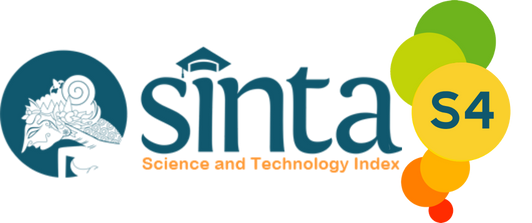PENCEGAHAN CARIES BAGI ANAK-ANAK DI RUMAH BELAJAR IDE-ID, TANGGA BUNTUNG PALEMBANG
DOI:
https://doi.org/10.25273/jta.v4i1.3812Keywords:
Caries, IDE-Id, Tooth, IDE-ID, GigiAbstract
Abstract: This activity aims to find out 1) the participation of children in the effort to prevent caries, and 2) to provide knowledge about efforts to prevent caries, given that the Palembang environment is very much found in sweet and sour foods, such as vinegar. The methods and techniques of service include discourse, and videos. Behavior as the target of intervention has 3 domains, namely: knowledge, attitudes and actions. The activity began with a location and target survey, followed by the delivery of material, question and answer. The area of the tooth that is cleaned includes the top, bottom, sides and tongue. The results of this activity explained that 1) all active participants followed the instructions very enthusiastically. and 2) other precautions, namely by changing the habit of consuming sweet and acidic foods excessively and selecting good pasta and toothbrushes. Awareness of maintaining dental and oral health is an effort to prevent caries from maintaining and enhancing the degree of personal health. The conclusion of this activity is 1) the participation of children in IDE-ID learning houses is very active and enthusiastic, and 2) information conveyed to children in IDE-ID Learning Houses about efforts to prevent caries including changing the habit of consuming sweet and sour foods excessive, and make a selection of pasta and brush your teeth properly.
Kata kunci : Caries, IDE-Id, Tooth
Â
Abstrak: Kegiatan ini bertujuan untuk mengetahui 1) partisipasi anak-anak dalam upaya pencegahan caries, dan 2) memberikan pengetahuan tentang upaya pencegahan caries, mengingat lingkungan Palembang sangat banyak ditemukan makanan manis maupun asam, seperti cuka. Metode dan teknik pengabdian meliputi ceramah, dan video. Perilaku sebagai sasaran intervensi mempunyai 3 domain, yakni: pengetahuan, sikap dan tindakan. Kegiatan dimulai dengan survey lokasi dan sasaran, dilanjutkan dengan penyampaian materi, tanya jawab. Area gigi yang dibersihkan meliputi bagian atas, bawah, samping, dan lidah. Hasil kegiatan ini menjelaskan bahwa 1) seluruh peserta aktif mengikuti petunjuk dengan sangat antusias. dan 2) tindakan pencegahan lain yakni dengan merubah kebiasaan mengkonsumsi makanan manis dan asam secara berlebihan dan pemilihan pasta dan sikat gigi yang baik. Kesadaran menjaga kesehatan gigi dan mulut merupakan upaya pencegahan caries untuk memelihara dan mempertinggi derajat kesehatan diri. Kesimpulan dari kegiatan ini 1) partisipasi anak-anak di rumah belajar IDE-ID sangat aktif dan antusiasi, dan 2) informasi yang disampaikan kepada anak-anak di Rumah Belajar IDE-ID tentang upaya pencegahan caries diantaranya merubah kebiasaan mengkonsumsi makanan manis dan asam secara berlebihan, dan melakukan pemilihan pasta dan sikat gigi dengan benar.
Keywords: Caries, IDE-ID, GigiDownloads
References
Arisman. 2004. Gizi dalam Daur Kehidupan. Jakarta: EGC.
Asse, R. 2010. Kesehatan Gigi dan Dampak Sosialnya. Diakses dari http://kesehatan.kompasiana.com/medis/2010/11/23/kesehatan-gigi-dandampak-sosialnya-catatan-dari-maratua-320506.
Begzati, A., Berisha, M., Meqa, K. 2010. Early Childhood Caries in Preschool Children of Kosovo a Serious Public Health Problem. BMC Public Health. Diakses dari http://www.biomedcentral.com/1471-2458/10/788.
Brown, JP and Dodds, MWJ. 2008. Dental Caries and Associated Risk Factors. In: Cappelli DP and Mobley CC. Prevention and Clinical Oral Health Care. Missuori: Mosby Elsevier.
Casamassimo, PS., Fields, HW., Mc Tigue, DJ., Nowak, AJ. 2013. Pediatric Dentistry: Infancy Through Adolescence Fifth Edition. Missouri: Elsevier.
Chu S. 2008. Riview – Early Childhood Caries: Risk and Prevention in Underserved Population. Diakses dari http://www..jyi.org/research/ re.php?id=717.
Depkes RI. 1999. Profil Kesehatan Gigi dan Mulut di Indonesia pada Pelita VI. Jakarta: Direktorat Kesehatan Gigi, Depkes RI.
Heriandi, S. 2002. Penanggulangan Karies Rampan serta Keluhannya pada anak. FKG. Jakarta: UI.
Kumala P, dkk. 2006. Kamus Saku Kedokteran Dorland. Jakarta; EGC.
Mitchell, L. 2014. Kedokteran Gigi Klinik: Semua Bidang Kedokteran Gigi. Edisi 5. Jakarta: EGC.
Notoadmodjo, S. 2011. Kesehatan Masyarakat Ilmu dan Seni Edisi Revisi. Jakarta: Rineka Cipta.
RISKESDAS/Riset Kesehatan Dasar. 2007. Jakarta: Badan Penelitian dan Pengembangan Kesehatan, Departemen Kesehatan, Republik Indonesia.
Sariningsih, E. 2012. Merawat Gigi Anak Sejak Usia Dini. Jakarta: Elex Media Komputindo.
Suresh, B. S., Ravishankar, T. L., Chaitra, T. R., Mohapatra, A. K., Gupta, V. 2010. “Mother Knowledge about pre-school Child’s oral Healthâ€. Journal of Indian Society of Pedodontics and Preventive Dentistry. Vol. 28, No 4, 282- 287.
The World Oral Health Report. 2003. Continuous Improvement of Oral Health in the 21st Century-the approach of the WHO Global Oral health Programme. Diakses dari the World Health Organization. (file in pdf). http://www.who.int.
Downloads
Published
Issue
Section
License
With the receipt of the article by Jurnal Terapan Abdimas Editorial Board and the decision to be published, the copyright regarding the article will be transferred to Jurnal Terapan Abdimas.
Jurnal Terapan Abdimas has the right to multiply and distribute the article and every author is not allowed to publish the same article that was published in this journal.
Every accepted manuscript should be accompanied by "Copyright Transfer Agreement" prior to the article publication.
Jurnal Terapan Abdimas by http://e-journal.unipma.ac.id/index.php/jta is licensed under a Creative Commons Attribution-ShareAlike 4.0 International License.
Â
Â





